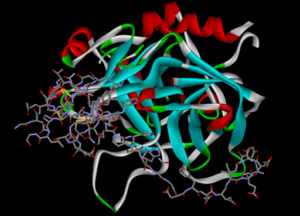 Thrombin plays a very important role in normal and pathological blood coagulation because its high level is an indication of tumor cell presence. Also, the level of thrombin is growing while atherosclerosis, thromboembolic disease, cancer, and inflammatory disease. Thus, its clinical importance provokes the development of devices for fast and precise thrombin detection and most of them are based on aptamers.
Thrombin plays a very important role in normal and pathological blood coagulation because its high level is an indication of tumor cell presence. Also, the level of thrombin is growing while atherosclerosis, thromboembolic disease, cancer, and inflammatory disease. Thus, its clinical importance provokes the development of devices for fast and precise thrombin detection and most of them are based on aptamers.
One of the ways to solve the problem is the use of optical-fiber grating-based sensors that have a great range of advantages:
- high level of sensitivity;
- multiplexing ability;
- compact size;
- lightweight;
- possibility of multi-modal sensing;
- tolerance to electromagnetic interference;
- low manufacturing cost.
All FBG sensors are based on different operation principles. There are LPG, etched fiber Bragg gratings, tilted FBG, microstructured Bragg gratings, photonic crystal fibers, or PCF. Nowadays the development of these types of sensors, especially, those which can detect thrombin, is the primary objective.
Etched fiber Bragg grating (EFBG) is one of them, its manufacturing is highly simple and fast because it has chemical etching liquids (for example, hydrofluoric acid) that are able to take away the cladding very quick at a controlled rate. Also, EFBG differs from core-exposed micromachined gratings by the absence of a laser micromachining station that makes the process of fabrication harder.
In spite of the fact that etched fiber Bragg gratings sensors have less sensitivity than in other types, there are numerous advantages over these sensing devices. For example, EFBG systems obtain simple adjustability of their sensitivity. Moreover, there is no need for a polarization control because etched Bragg gratings measure reflection.
This optical-fiber grating-based sensing system operates with a wavelength of 1550 nm, uses hydrofluoric acid as etching fluid for approximately 27 minutes. It is able to detect thrombin in concentrations ranging from 10 nM to 80 nM and the use of EFBG has a promising future as the manufacture of FBG biosensors needs only chemical etching, also it is simple and less expensive than other types of sensing systems. Moreover, etching fiber Bragg grating sensors are easy for multiplexing and, consequently, can be used in vivo. Finally, all the advantages expand the opportunities for thrombin detection.
Optromix is a fiber Bragg grating (FBG) products manufacturer that offers FBG sensors, FBG interrogators and multiplexers, DAS systems, DTS systems. Optromix creates and supplies a broad variety of fiber optic solutions for monitoring worldwide. If you have questions or would like to buy FBG products, please contact us at info@optromix.com

